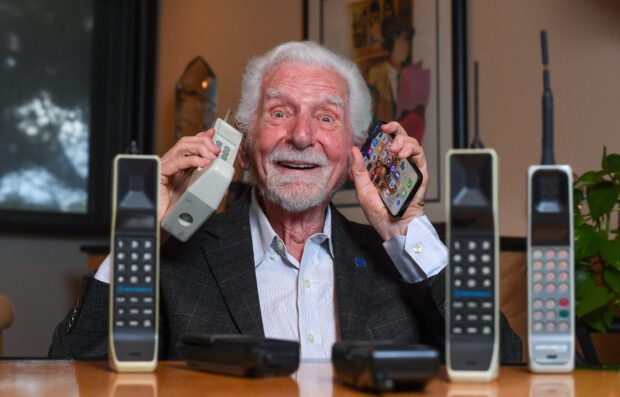
Engineer Martin Cooper holds in his right hand a contemporary copy of the original cell phone he used to make the first cell phone call on April 3, 1973, in Del Mar, California on March 20, 2023. – The problem with mobile phones is that people look at them too much. At least, that’s according to the man who invented them 50 years ago. Martin Cooper, an American engineer dubbed the “Father of the cell phone,” says the neat little device we all have in our pockets has almost boundless potential and could one day even help conquer disease. But right now, we can be a little obssessed. (Photo by VALERIE MACON / AFP)
Paris, France — From brick-sized handsets popular with stockbrokers to intensely powerful computers that sit in all our pockets today, mobile phones have been forged by a half-century of innovation.
1973: Hello, moto
On April 3, 1973, an engineer at the US firm Motorola makes the first call from a mobile device, dubbed DynaTAC.
Martin Cooper calls Joel Engel, a competitor working for Bell Labs, from 6th Avenue in New York.
But it takes a further 10 years for the first mobile to be marketed.
In 1983, Motorola starts selling the DynaTAC 8000X in the United States for a cool $3,995.
Nicknamed the brick, it weighs just shy of a kilo and measures 33 centimetres.
1992: ‘Merry Christmas’
On December 3, 1992, Vodafone employee Richard Jarvis receives the first text message.
His computer wishes him “Merry Christmas”.
The message would one day sell at auction in the form of an NFT in 2021 for $150,000.
1997: Finn-ovation
Finnish brand Nokia begins a string of innovations that pushes the boundaries of mobile.
In 1997 its 6110 model introduces mobile games to the masses with “Snake”.
Two years later the 7110 is the first phone to use wireless networks for browsing, and the same year the 3210 brings predictive writing to the world.
In 2003, Nokia launches its affordable, robust 1100 model, targeting developing countries. It shifts 250 million units, making it the best-selling phone in history.
2001: 3G in Japan
In 2001, Japan is the first country to benefit from a 3G mobile network, allowing high-speed internet access.
It comes hot on the heels of other Japanese innovations including a phone with video-calling capabilities, the Kyocera VP-210 in 1999, and a year later the Sharp SH04, the first with a built-in back camera.
2007: First iPhone
“Today, Apple is going to reinvent the phone,” says Steve Jobs as he presents the iPhone to an adoring crowd in 2007.
He promises an iPod, a phone and an “internet communicator” all in one device, which eventually retails for between $499 and $599.
The App store is introduced in 2008.
The same year, the HTC Dream is the first smartphone released with Google’s Android operating system.
2009: Rise of the messenger
WhatsApp launches in 2009 and is quickly followed by many other messenger apps — Viber, WeChat, Telegram, Signal.
These apps, which use the internet rather than traditional networks, become more popular than SMS in 2012.
Stockholm is the first city to offer users very high-speed 4G coverage in 2009.
2011: ‘Emoji’ fever
Siri arrives in 2011, allowing users of Apple’s iPhone 4S to send messages, set appointments, make calls or even search the internet by simply asking your phone.
Google and Amazon develop competing voice assistants in the years after.
In the same year, “emoji” fever seizes the planet when the tiny faces, sketched in 1999 by Shigetaka Kurita, are integrated into the character library of the iPhone.
2019: 5G, foldables
On April 5, 2019, South Korea becomes the first country covered by 5G with the promise of even faster navigation.
In the same year, South Korean firm Samsung and China’s Huawei are the first major manufacturers to release foldable screen smartphones, the Galaxy Fold and the Mate X.